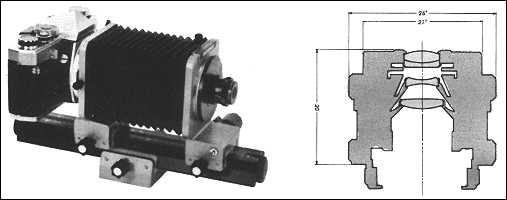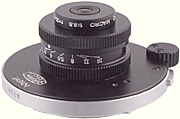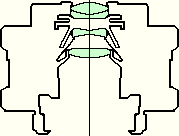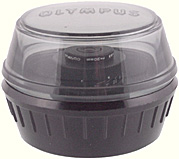Olympus OM system close-up and macro equipment
Zuiko Macro Lens 20 mm f/3.5
Introduction
This is one of the original set of 3 bellows macro lenses for the Olympus OM system and was first produced in 1972. Unlike any of the other OM lenses, this one has a continuously variable manual diaphragm with no click-stops and no pre-set ring. Exposure has to be measured with the diaphragm closed down to the desired aperture. Focusing is easier and more accurate with the diaphragm wide open. Like the other 2 manual macro lenses, the aperture scale appears upside down when viewed from behind the camera. This is because this lens was expected to be used pointing downwards on a copy stand or a macro stand, so that the scale appears right way up when viewed from the front.
This macro lens is designed for magnifications from 4× to 12× and so it is appropriate for objects ranging from 6×9 mm down to 2×3 mm.
The Zuiko Macro 20mm f/3.5 lens is intended for use with the Auto Bellows, although it can also be used with the Telescopic Auto Tube 65–116 that was introduced in 1980. It can also be used with extension tubes, but with fixed magnifications.
The Zuiko Macro 20mm has a small screw thread mount (RMS – Royal Microscopical Society – thread, 0.8″ diameter, 36 t.p.i.), the same as many microscope objectives, and requires an Objective Lens Mount PM-MTob to convert it to the OM bayonet fitting.
This lens pre-dates the macro flash units, and so does not have a filter mount for attaching them. However, it is possible to use strong glue to fix an empty 49mm filter mount to the front of the PM-MTob adapter.
In 197?, this lens was discontinued and replaced by the Zuiko Auto-Macro 20mm f/2 lens, which is faster, has an automatic diaphragm, has a standard OM bayonet instead of the RMS screw thread, has helicoid fine focusing, and has a 49mm filter mount for attaching the macro flash units.
Versions
- ZUIKO MACRO f=20mm 1:3.5 (single coated) (200xxx)
- ZUIKO MACRO 1:3.5 f=20mm (single coated) (200xxx, 201xxx)
- ZUIKO MC MACRO 1:3.5 f=20mm (multicoated) (202xxx, 203xxx, 300xxx)
- ZUIKO MACRO 1:3.5 f=20mm (multicoated) (300xxx)
- ZUIKO MACRO 20mm 1:3.5 (multicoated) (301xxx)
Features
|
|
Magnification range with Auto Bellows
| Lowest magnification | ×4.3 | Subject area | 8.4×5.6 mm | Working distance | 21 mm |
|---|---|---|---|---|---|
| Highest magnification | ×12.4 | Subject area | 2.9×1.9 mm | Working distance | 18 mm |
Magnification range with Telescopic Auto Tube 65–116
| Lowest magnification | ×? | Subject area | ?×? mm | Working distance | ? mm |
|---|---|---|---|---|---|
| Highest magnification | ×? | Subject area | ?×? mm | Working distance | ? mm |
Accessories
The Objective Lens Mount PM-MTob is required in order to mount the lens on the Auto Bellows. A Lieberkühn Reflector and a Mirror Housing were made to fit this lens.
See also: Close-up and Macro Photography – Bellows Macro Lenses
Going digital
The Zuiko Macro 20mm f/3.5 has no interaction with the camera body. The click-stop mechanism for closing the iris diaphragm works exactly the same on film and digital cameras.
The following tables are based on those in the instruction leaflet, with adjustments for different sensor sizes (smaller sensors reduce the field of view) and for any additional extension needed to allow the release lever on the rear of the Auto Bellows to clear an overhanging pentaprism or flash.
Magnification and field of view for Auto Bellows with Canon EOS 5D MkII
36×24 mm sensor, with 7 mm extension tube between bellows and OM/EOS adapter
| Magnification | 5.0 | 6.0 | 7.0 | 8.0 | 9.0 | 10.0 | 11.0 | 12.0 |
|---|---|---|---|---|---|---|---|---|
| Subject area (mm) | 7.2 × 4.8 | 6.0 × 4.0 | 5.1 × 3.4 | 4.5 × 3.0 | 4 × 2.7 | 3.6 × 2.4 | 3.3 × 2.2 | 3.0 × 2.0 |
| Bellows scale* (mm) | 69 | 89 | 109 | 129 | 149 | 169 | 189 | 209 |
| Lens to subject distance (mm) | 21 | 20 | 19 | 19 | 19 | 19 | 18 | 18 |
Magnification and field of view for Auto Bellows with Canon EOS 40D
22.2×14.8 mm APS-C sensor, with 14 mm extension tube between bellows and OM/EOS adapter
| Magnification | 5.0 | 6.0 | 7.0 | 8.0 | 9.0 | 10.0 | 11.0 | 12.0 |
|---|---|---|---|---|---|---|---|---|
| Subject area (mm) | 4.4 × 3.0 | 3.7 × 2.5 | 3.2 × 2.1 | 2.8 × 1.85 | 2.5 × 1.6 | 2.2 × 1.5 | 2.0 × 1.3 | 1.85 × 1.2 |
| Bellows scale* (mm) | 76 | 96 | 116 | 136 | 156 | 176 | 196 | 216 |
| Lens to subject distance (mm) | 21 | 20 | 19 | 19 | 19 | 19 | 18 | 18 |
Magnification and field of view for Auto Bellows with Olympus E-1, E-300, E-330 and Micro Four Thirds
17.3×13.0 mm Four-Thirds sensor, with no extension tube between bellows and OM/Four Thirds adapter
| Magnification | 5.0 | 6.0 | 7.0 | 8.0 | 9.0 | 10.0 | 11.0 | 12.0 |
|---|---|---|---|---|---|---|---|---|
| Subject area (mm) | 3.5 × 2.6 | 2.9 × 2.2 | 2.5 × 1.9 | 2.2 × 1.6 | 1.9 × 1.4 | 1.7 × 1.3 | 1.6 × 1.2 | 1.4 × 1.1 |
| Bellows scale* (mm) | 83 | 103 | 123 | 143 | 163 | 183 | 203 | 223 |
| Lens to subject distance (mm) | 21 | 20 | 19 | 19 | 19 | 19 | 18 | 18 |
Magnification and field of view for Auto Bellows with Olympus E-3, E-410, E-500, E-510, E-620
17.3×13.0 mm Four-Thirds sensor, with 7 mm extension tube between bellows and OM/Four Thirds adapter
| Magnification | 5.0 | 6.0 | 7.0 | 8.0 | 9.0 | 10.0 | 11.0 | 12.0 |
|---|---|---|---|---|---|---|---|---|
| Subject area (mm) | 3.5 × 2.6 | 2.9 × 2.2 | 2.5 × 1.9 | 2.2 × 1.6 | 1.9 × 1.4 | 1.7 × 1.3 | 1.6 × 1.2 | 1.4 × 1.1 |
| Bellows scale* (mm) | 76 | 96 | 116 | 136 | 156 | 176 | 196 | 216 |
| Lens to subject distance (mm) | 21 | 20 | 19 | 19 | 19 | 19 | 18 | 18 |
* The bellows scale should be read at the rear of the body mount, with the lens mount positioned at the front end of the rail.
Instruction leaflet
ZUIKO MACRO F3.5 f=20mm

This lens was designed exclusively for macrophotography in conjunction with the Auto Bellows (an optional coupling attachment is necessary). The assignment for this lens is to exert high resolution and contrast at magnifications from 4× (5mm × 8mm) to 12× (2mm × 3mm). In macrophotography at such high magnifications, illumination, camera stability and subject’s position become hard to fine-adjust. The use of a macrophoto stand and accessorial illumination devices is recommended. The PMT-35, a highly sophisticated macrophoto apparatus, is available for advanced amateurs and skilled experts. It accepts a 21mm slip-on type polarizing filter.
Specifications
• Focal length: 20mm • Angle of view: 9° (at high magnification) • Optical construction: 4 elements in 3 groups • Diaphragm operation: Manual • F stop range: 3.5–16 • Minimum focus: 0.13m (5.1″) • Minimum photographic range: 5mm x 8mm – 2mm x 3mm • Focusing: With Auto Bellows • Weight: 50g (1.8oz) • Length: 20mm (0.8″) Maximum diam: 26mm (1″)
CLOSE-UP TABLE
| Subject Area Covered mm | 8 × 5.3 | 7.2 × 4.8 | 6.5 × 4.4 | 6 × 4 | 5.5 × 3.7 | 5.1 × 3.4 | 4.8 × 3.2 | 4.5 × 3.0 | 4 × 2.7 | 3.6 × 2.4 | 3.3 × 2.2 | |
|---|---|---|---|---|---|---|---|---|---|---|---|---|
| Magnification | 4.5 | 5.0 | 5.5 | 6.0 | 6.5 | 7.0 | 7.5 | 8.0 | 9.0 | 10.0 | 11.0 | |
| Scale (mm) | 68 | 73 | 83 | 93 | 103 | 113 | 123 | 133 | 143 | 163 | 183 | 203 |
| Lens vertex-to-subject distance (cm) | 2.1 | 2.1 | 2.1 | 2.0 | 2.0 | 2.0 | 1.9 | 1.9 | 1.9 | 1.9 | 1.9 | 1.8 |
CLOSE-UP TABLE
| Subject Area Covered (in) | 9/32 × 3/16 | 15/64 × 5/32 | 13/64 × 9/64 | 11/64 × 1/8 | 9/64 × 3/32 | |||||||
|---|---|---|---|---|---|---|---|---|---|---|---|---|
| Magnification | 4.5 | 5.0 | 5.5 | 6.0 | 6.5 | 7.0 | 7.5 | 8.0 | 9.0 | 10.0 | 11.0 | |
| Scale (mm) | 68 | 73 | 83 | 93 | 103 | 113 | 123 | 133 | 143 | 163 | 183 | 203 |
| Distance from lens to subject (in) | 53/64 | 53/64 | 53/64 | 25/32 | 15/32 | 15/32 | 3/4 | 3/4 | 3/4 | 3/4 | 3/4 | 45/64 |
OLYMPUS
OLYMPUS OPTICAL CO. LTD.
43-2 Hatagaya 2-chome, Shibuya-ku, Tokyo, Japan
Exploded parts diagram
Send comments or questions to Alan Wood
![]()
Created 18th May 2001 — Updated 28th February 2021
Copyright © 2001–2021 Alan Wood


